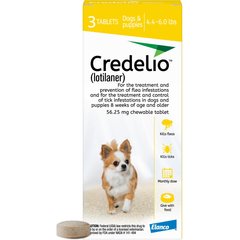How Long Do Flea and Tick Medications Take to Work on Dogs?
SPONSORED BY
iStock/Dmitrii Anikin
If you’ve found fleas or ticks on your dog, don’t panic. With the right treatment, these common pests can be quickly eradicated for good—often within just a few hours.
The quicker you can kill fleas and ticks, the better, as they can cause serious health problems for your pet, including flea allergy dermatitis, tapeworms, Lyme disease, anaplasmosis, and ehrlichiosis. In most cases, a tick must be attached to your dog for at least 24-48 hours to transmit an infection, making it even more important to act quicky to kill and remove insects that have attached to your pet.
Fortunately, fast-acting flea and tick protection such as CredelioTM begin to work within hours of the first dose, starting to kill pests within four hours. After ticks are dead, check to make sure the insect has fallen off—even dead ticks can sometimes remain attached to the skin—and continue to routinely check your dog’s skin to make sure it’s clear from dangerous pests.
Signs Flea and Tick Medication Is Working on Your Dog
After administering flea and tick medication to your dog, you should start seeing dead fleas within 24 hours. Even after the fleas are killed, it may take a few days for the itching to decrease. Once treatment has started, most veterinarians recommend regular monthly treatment throughout the full year to keep pests away for good. The flea life cycle from egg to adult is about three months, and some medications only treat the adult fleas.
Ticks are hardier than fleas, so it will take longer (closer to 24–48 hours depending on the type of treatment) for a treatment to work. Dead ticks may or may not fall off your dog. It is generally recommended to have dead ticks removed by a veterinarian as soon as possible to ensure that the head of the tick, which can be buried under your dog’s skin, is completely removed.
Oral Flea and Tick Preventive Medication
While topical preventives have historically been the most common, newer oral preventives are proving their worth with their rapid efficiency and ease of use. These chews and tablets for dogs with fleas and ticks are great for pet households with multiple species or young children in the home. Oral preventives are currently the most recommended product types by veterinarians.
-
Isoxazoline: Isoxazoline medications are a newer and highly effective preventive that offer great efficacy against fleas and several types of ticks. This class of medications includes CredelioTM, a chewable tablet that’s provided monthly and has been shown to start killing fleas and ticks (Ixodes Ricinus) within four hours of the first dose. Although generally considered safe, isoxazoline medications have been associated with adverse reactions in some pets. When choosing a flea and tick preventive, your vet can help you make the best decision based on your pet’s medical history.
-
Spinosad: Spinosad is an effective oral flea preventive.
-
Nitenpyram: This is currently the only over-the-counter oral preventive. It works quickly but is only effective for 24 hours.
-
Milbemycin/lufenuron: Milbenmycin is a heartworm preventive and lufenuron is a flea prevention. Lufenuron does not kill fleas.
Topical Flea and Tick Preventive Medication
Topical preventions are liquid products generally applied to the skin at the neck's nape. These products can be toxic when ingested (especially if a cat ingests a dog flea preventive, so it is important that these products have dried on dogs before other pets or children are allowed to interact with them. Bathing may affect the efficacy of these products; please see the product packing for more information.
Flea and Tick Preventive Medication Collar
These products are not all equally effective. Generally, older products use insect growth regulator ingredients (like tetrachlorvinphos or deltamethethrine) which vary in efficacy. These products should not be handled by young children. Seresto® is a newer product and has greater efficacy than older products. It is labeled for over-the-counter use in dogs, works within hours, and can be effective for up to eight months.
After handling any flea and tick prevention collars, pet parents should wash their hands thoroughly.
How To Get Rid of Fleas and Ticks in Your Home
To get rid of all fleas and ticks, you must do more than just administer medication to your dog. It’s important to also:
-
Ensure that all pets in the home are on flea and/or tick prevention. This includes dogs, cats, ferrets, and rabbits.
-
Vacuum daily to remove flea eggs and larvae, even if you have hardwood or tile flooring. Make sure to discard the vacuum bag or empty the canister immediately after use.
-
Wash all bedding with hot water weekly.
-
Bathe your dog weekly to remove dead fleas if you’re managing a flea infestation.
-
Keep a neat yard. Fleas and especially ticks love shaded, dense areas, so keep a distance between your home and any forested areas, dense brush, or tall grasses.
-
Consider having a professional company come to spray your home and yard; just be sure it is a pet-friendly treatment.
-
Ask your vet about insecticides for home use. Sprays, bug bombs, or powders can be beneficial, but it’s crucial to only use pet-safe products and follow the instructions carefully.
Watch this tutorial for step-by-step instructions on how to get rid of fleas in the home.
Treating Additional Problems Related to Fleas and Ticks
Flea Allergy Dermatitis
Fleas and ticks can cause itching, skin irritation, and inflammation. The greater the number of these pests, the more irritation. Many dogs are allergic to flea saliva, which can cause a skin condition called flea allergy dermatitis. Symptoms may include inflammation, itching, open sores, scabs, and hair loss secondary to the allergic reaction to the flea bite. The loss of fur and skin irritation most commonly appears around the lower back, tail, or hind legs. That’s why it is so important to get rid of fleas fast—to reduce the risk of an allergic reaction.
In addition to starting flea and tick medication, treatment may include use of medicated shampoos, medicated wipes, oral antibiotics, or anti-inflammatories, depending on the severity of the dermatitis.
Anemia
In large enough numbers, fleas and ticks can cause anemia in dogs as they ingest a blood meal from our pets. If that happens, your pet may have pale gums or be lethargic. Treatment may be as simple as giving your pet an oral iron supplement, or if the anemia is serious enough, it may require that your pet get a blood transfusion.
Additional Diseases from Fleas and Ticks
While fleas and ticks can do a vast amount of damage to pets by themselves, they also can carry other diseases that can sicken your dog. Fleas are very likely to carry tapeworms, an intestinal parasite, and several types of bacterial diseases such as plague. If your dog has fleas and develops any additional symptoms like diarrhea, vomiting, or lethargy, talk to your veterinarian. They may recommend additional testing for one or more of these conditions.
Ticks often carry bacteria that may cause diseases including Lyme disease and Rocky Mountain Spotted Fever. Ask your vet if your dog should be tested for common tick-borne illnesses. If your pet has contracted a tick-borne disease, additional treatments such as antibiotics will likely be needed.
Flea and Tick FAQ
What age can puppies start flea and tick medicine?
Most flea and tick treatments for dogs are not safe to use until the puppy is 8 weeks old, although some medications can be used on puppies as young as 4 weeks old or not until they are 24 weeks old. The dog’s weight is also a factor. Always consult with the label on the product and your veterinarian to determine the right product for your specific puppy.
What diseases are transmitted by fleas and ticks?
Fleas and ticks can cause a range of health problems for pets and people. Fleas can carry tapeworms and bacterial diseases such as plague. Ticks-borne illnesses include Lyme disease and Rocky Mountain Spotted Fever. Fleas and ticks both can cause anemia and various skin issues, including flea allergy dermatitis—all the more reason to kill fleas and ticks fast and prevent reinfestation.
What other parasites should I protect my dog against?
In addition to fleas and ticks, other parasites, both external and internal, can spell trouble for your dog, including mites, heartworms, roundworms, hookworms, whipworms and tapeworms. Parasiticides can prevent and treat common parasite infections. For example, Interceptor Plus dog chews prevent heartworm disease; plus it treats and controls adult hookworm, roundworm, whipworm and tapeworm infections. Talk to your vet about parasite protection that’s tailored to your pet’s needs.
This sponsored article was paid for by Credelio. All opinions within belong to Credelio.
References
-
Dobler G, Pfeffer M. Fleas as parasites of the family Canidae. Parasites & Vectors. 2011;4(139).
-
Rust MK. The Biology and Ecology of Cat Fleas and Advancements in Their Pest Management: A Review. Insects. 2017;8(4):118.
-
Saleh M, Sundstrom K, Duncan K, et al. Show us your ticks: a survey of ticks infesting dogs and cats across the USA. Parasites & Vectors. 2019;12:595.
-
Sischo W, Ihrke P, Franti C. Regional distribution of ten common skin diseases in dogs. Journal of the American Veterinary Medical Association. 1989;195(6):752-756.
-
Cruthers L, Slone R, Guerrero A, Robertson-Plouch C. Evaluation of the speed of kill of fleas and ticks with Frontline Top Spot in dogs. Veterinary Therapeutics: Research in applied veterinary medicine. 2001;2(2):170-174.
-
Everett R, Cunningham J, Arther R, Bledsoe D, Mencke N., Norbert. Comparative evaluation of the speed of flea kill of imidacloprid and selamectin on dogs. Veterinary Therapeutics: Research in applied veterinary medicine. 2000;(1):229-34.
-
Franc M, Bouhsira E, Böhm C, et al. Evaluation of spinosad for the oral treatment and control of flea infestations on cats in Europe. Veterinary Record Open. 2014;1(1).
-
Six R, Becskei C, Carter L, et al. Evaluation of the speed of kill, effects on reproduction, and effectiveness in a simulated infested-home environment of sarolaner (Simparica) against fleas on dogs. Veterinary Parasitology. 2016;222:23-27.
-
Stanneck D, Kruedewagen E, Fourie J, et al. Efficacy of an imidacloprid/flumethrin collar against fleas, ticks, mites, and lice on dogs. Parasites & Vectors. 2002;5(102).
-
Cavalleri D. et al 2017. "Assessment of the speed of flea kill of lotilaner (Credelio™) throughout the month following oral administration to dogs." Parasites & Vectors. 10:529.
-
Murphy M. et al 2017. "Laboratory evaluation of the speed of kill of lotilaner (Credelio™) against Ixodes ricinus ticks on dogs." Parasites & Vectors. 10:541.


